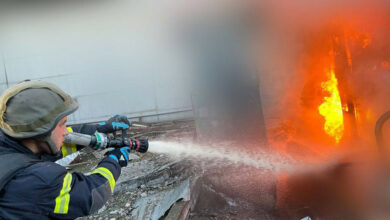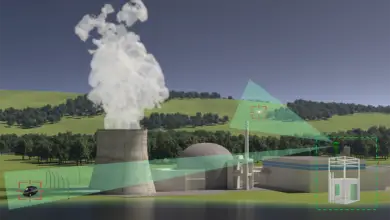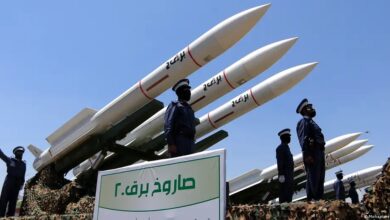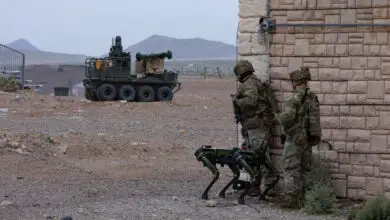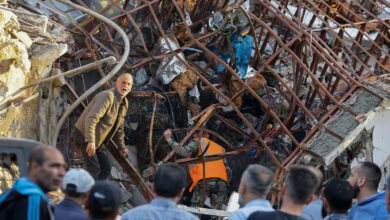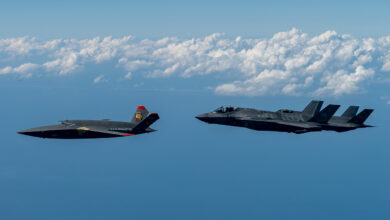US extends carrier strike group Middle East mission, sends Patriot missile defense system to Iraq
USS Harry S. Truman and USS Dwight D. Eisenhower deployment extension is the first period of extended dual US carrier operations in the region since April 2012
The U.S. military extended the deployment of two aircraft carrier strike groups in the Middle East and has begun moving Patriot air defense missile systems into Iraq after an attack blamed on a Hashd al-Shaabi militia.
“We’re moving Patriots into Iraq now,” Central Command Commander General Kenneth McKenzie said Friday, March 13, just days after a rocket barrage on Camp Taji airbase killed two U.S. military personnel and a British soldier, and wounded others deployed to the U.S.-led Coalition against Islamic State.
McKenzie said U.S. Defense Secretary Mark Esper approved his request to extend the deployment of the USS Harry S. Truman carrier strike group, which has been in CENTCOM’s area of operations since December. “We’re gonna keep them for a while,” McKenzie said, declining to specify how long.
The USS Dwight D. Eisenhower aircraft carrier joined the USS Truman and the Bataan Amphibious Ready Group in the CENTCOM area of operations earlier this month.
Typically only one carrier strike group operates in CENTCOM’s area of responsibility. Keeping the Truman in theater marks the first period of extended dual U.S. carrier operations in the region since April 2012.
“The carriers are very important to us, and we know the Iranians watch them very closely too,” McKenzie said.
The U.S. administration has sought to “restore deterrence” against Iran in the Middle East after a series of attacks attributed to regional militias connected to Tehran’s Islamic Revolutionary Guard Corps.
Iran has denied responsibility for the attacks, including the devastating cruise missile strike on Saudi Arabia’s Aqbaiq and Khurais oil facilities and sabotage of oil tankers in the Persian Gulf last year.
In January, the Trump administration ordered IRGC Quds Force commander Qassem Soleimani killed in a drone strike in Baghdad following a series of provocations by both sides following the death of a U.S. contractor in a rocket strike in Iraq a month prior.
The U.S. carried out retaliatory strikes in Iraq early on Friday against what McKenzie said were storage sites for “advanced conventional weapons” provided by Iran to Kataib Hezbollah, a Hashd al-Shaabi (Popular Mobilization Units) militia with links to Iran’s Islamic Revolutionary Guard Corps.
McKenzie said he was confident the “defensive precision strikes” would help deter further attacks, but the new air defense systems suggest Washington is hedging its bets in Iraq.
Patriot air defense missile system deployment
McKenzie said that the U.S. military in Iraq is “still some days away” from being ready to deploy Counter-Rocket, Artillery and Mortar (C-RAM) systems, which he said will be used to defend the high-value Patriot batteries against smaller rockets.
The general first announced the deployment of air defenses to Iraq during a hearing before the House Armed Services Committee on Thursday, but did not specify which systems would be sent.
During a separate hearing on Thursday, lawmakers questioned the head of U.S. Army Space and Missile Defense Command, Lieutenant General Daniel Karbler, on why there were no C-RAM systems at Camp Taji. C-RAMs are designed to intercept rockets like those that killed the Coalition personnel.
“We have more locations in the theater where we have soldiers, sailors, airmen and Marines than we have the ability to protect,” McKenzie told reporters at the Pentagon on Friday. “So we have to ruthlessly prioritize. We can’t have C-RAM everywhere we want it to be … There just wasn’t one at Taji.”
McKenzie did not specify which C-RAM systems would be sent to Iraq. Karbler on Thursday said the Army’s two Iron Dome units would not be ready for deployment anywhere until the end of the year.
The U.S. has sought to move Patriot missile batteries into Iraq since an Iranian ballistic missile barrage struck two Iraqi bases in January in response to the killing of Soleimani.
More than 100 U.S. military personnel have been diagnosed with concussive brain injuries as a result of the Iranian missile attack.
Any Patriot missile deployment would require Iraqi government approval, American officials have said, a thorny matter since Iraq’s Parliament passed a motion in January to expel U.S. and foreign troops from the country in response to Soleimani’s killing. Iraq and the U.S. resumed counter-ISIS operations later that month.
U.S. officials said in January that Patriots had not been deployed to Iraq earlier because they had assessed Iran would be more likely to launch large ballistic missiles at other U.S. bases in the region. The Patriot’s primary role is to intercept ballistic missiles.
The Trump administration has engaged in a “maximum pressure” campaign against Iran since the U.S. withdrew from the 2015 nuclear agreement with Tehran.
Washington’s effort is built around debilitating economic sanctions and includes support for Israeli air strikes against IRGC-linked militias in Syria.
The U.S. accuses Iran of expanding its regional influence by arming and advising local armed groups in Iran, Syria and Yemen. It has also accused Iran of providing sophisticated missile and drone technology to its proxies, posing a threat to Washington’s regional allies Israel and Saudi Arabia.
The Pentagon has said it considers Iran-backed militias to be a greater threat than ISIS to the roughly 5,000 U.S. troops in Iraq.
“We believe we have established a level of state-to-state deterrence, in that Iran does not seek a large-scale military exchange with the United States,” McKenzie said on Friday. Still, the CENTCOM commander warned that risk of military action against U.S. and international forces in Iraq by Iran’s affiliate militias remained serious.
“I think tensions have not gone down,” McKenzie said.


